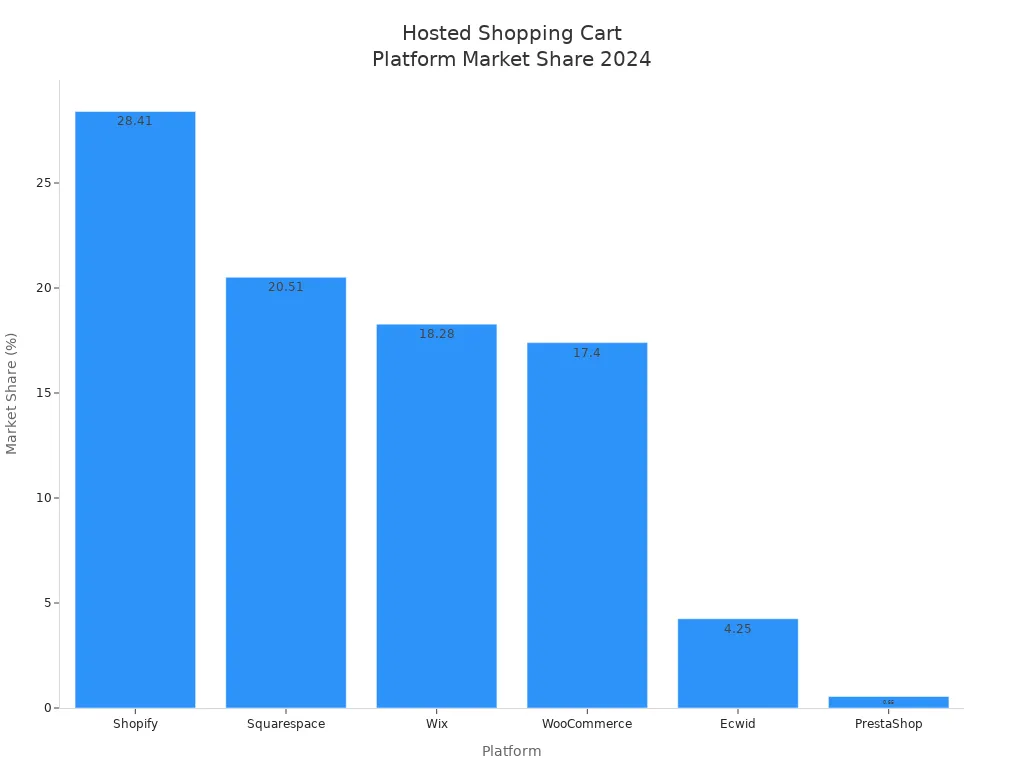Adding a Shopping Cart to Website using 4 Methods for Different Technical Skill Levels

You want your online store to give shoppers a smooth online shopping experience. Adding a shopping cart to your site makes buying easy and keeps customers happy. When you place a clear 'Add to Cart' button in a visible spot, shoppers notice it right away. This simple step encourages more people to buy and helps e-commerce businesses grow. If you streamline the checkout process, customers finish their purchases faster, so fewer carts get abandoned. A simple process and good user experience boost conversion rates and make your e-commerce site stand out. Ready to learn how to add shopping cart to your website? Let’s dive in!
Key Takeaways
Choose a shopping cart method that matches your technical skills and website type for the best results.
Hosted platforms like Shopify offer quick setup with no coding, perfect for beginners.
CMS plugins provide more customization but need moderate technical knowledge and maintenance.
HTML/JavaScript solutions give you design freedom but require some coding skills.
Custom-built carts offer full control and scalability but need advanced coding and more time.
Hosted Shopping Cart

How to Add Shopping Cart Easily
If you want the fastest way to add shopping cart to website, hosted shopping cart integration is your best friend. You do not need to know how to code or worry about technical details. You just pick a platform, sign up, and start selling. Popular hosted shopping cart software like Shopify, Squarespace, and Wix make the process simple. These platforms let you drag and drop products, set up your checkout process, and manage orders from one dashboard. You can even use PayPal or Stripe to handle payments. Hosted shopping cart integration works well for beginners or anyone who wants to launch a store quickly.
Here’s a look at the most popular hosted shopping cart platforms in 2024:
Platform | Market Share (2024) | Notes on Popularity and Usage |
|---|---|---|
Shopify | 28.41% | Leading platform in the US market and globally among top 1 million sites |
Squarespace | 20.51% | Second most popular hosted platform |
Wix | 18.28% | Strong presence in hosted ecommerce solutions |
WooCommerce | 17.40% | Popular open-source platform with hosted options, significant market share |
Ecwid | ~4.25% | Smaller share but notable presence |
PrestaShop | ~0.55% | Enterprise and open-source platform with smaller share |

Setup Steps
You can get started with hosted shopping cart integration in just a few steps:
Choose a shopping cart software like Shopify, Squarespace, or Wix.
Create an account and pick a template for your store.
Add your products and set prices.
Set up your payment methods, such as PayPal or Stripe.
Customize your checkout process and shipping options.
Launch your site and start selling.
Most hosted shopping cart platforms let you finish setup in minutes. You do not need to install anything or manage updates. The process is smooth and quick, so you can focus on your business.
Pros and Cons
Tip: Hosted shopping cart integration is perfect if you want to start selling fast and avoid technical headaches.
Pros:
Easy to use, even if you have no tech skills.
No need to worry about updates or security; the provider handles it.
Customer support is available if you need help.
Cons:
Customization is limited to what the platform offers.
You pay monthly or yearly fees, plus transaction fees.
If you want to switch platforms, the process can take time.
Hosted shopping cart integration gives you a simple way to manage your checkout process and shopping cart. You can focus on your products and customers while the platform handles the technical side.
CMS Shopping Cart Integration

How to Add Shopping Cart to Website with Plugins
If you already use a content management system like WordPress, Joomla, or Drupal, you can add a shopping cart to your website with plugins or extensions. This method works well if you know how to manage your website but do not want to build everything from scratch. Shopping cart integration with plugins lets you add products, set up a checkout process, and manage orders right from your CMS dashboard. WooCommerce is a popular shopping cart software for WordPress. It fits right in as a plugin and gives you lots of features. Other CMS platforms, like Joomla and Drupal, also offer shopping cart software, but the setup can be more complex and may need some coding skills.
Here’s a quick look at how integration differs across popular CMS platforms:
CMS Platform | Hosting Type | Technical Expertise Required | Integration Complexity | Key Integration Features | Suitability |
|---|---|---|---|---|---|
WooCommerce | Self-hosted | Moderate | Medium to high | Many extensions, open-source | Small to medium stores |
Joomla | Self-hosted | Higher | Medium to high | Flexible, needs CSS/PHP | Users with tech skills |
Drupal | Self-hosted | High | High | Scalable, customizable | Tech teams, large sites |
Wix | Hosted | Minimal | Low | Drag-and-drop, built-in | Non-technical users |
Setup Steps
You can follow these steps for shopping cart integration with most CMS platforms:
Choose a shopping cart plugin or extension that matches your CMS.
Install and activate the plugin from your CMS dashboard.
Add your products and set up prices.
Configure your checkout process, including payment and shipping options.
Test the shopping cart and checkout to make sure everything works.
Tip: Always keep your shopping cart software and plugins updated. This helps protect your site and keeps the checkout process smooth.
Pros and Cons
Using plugins for shopping cart integration gives you more control and flexibility than hosted solutions. You can customize your shopping cart, checkout, and overall process to fit your needs. You also avoid monthly fees from hosted platforms. However, you take on more responsibility for updates, security, and performance. Too many plugins can slow down your site or cause conflicts. Always choose reputable shopping cart software and test updates before going live. If you want seamless integration and a checkout process that matches your brand, CMS plugins are a great choice.
HTML/JavaScript Shopping Cart Integration
How to Add Shopping Cart to Static Sites
Do you have a static website and want to sell products? You can use HTML and JavaScript to add a shopping cart without switching platforms. This method works well if you know a bit of coding and want more control over your site’s look and feel. Many developers choose third-party shopping cart libraries like Snipcart or Cart.js. Snipcart lets you add a shopping cart to any site with just a few lines of code. It supports selling both physical and digital products, offers a fast checkout, and gives you dashboards for managing orders. Cart.js is another popular choice. It’s lightweight and open-source, and you can adapt it for static sites. Both options make shopping cart integration simple and flexible.
Tip: If you want seamless integration and a shopping cart that matches your brand, HTML/JavaScript solutions give you more freedom than most CMS or hosted platforms.
Setup Steps
You can follow these steps to add a shopping cart to your static site:
Pick a shopping cart library like Snipcart or Cart.js.
Sign up for an account if needed.
Copy the JavaScript snippet or code provided by the shopping cart service.
Paste the code into your site’s HTML where you want the shopping cart or checkout button to appear.
Add product details using simple HTML tags or data attributes.
Test the checkout process to make sure everything works smoothly.
This process lets you keep your site’s original design. You can also customize the shopping cart and checkout to fit your needs.
Pros and Cons
HTML/JavaScript shopping cart integration gives you more design flexibility than CMS or hosted solutions. You can control how your shopping cart looks and works. Snipcart, for example, lets you change the cart’s style and add custom features. Shoprocket is another tool that helps you keep your site’s look and feel while adding a shopping cart. These solutions support mobile devices, inventory management, and tax calculations. You get a secure checkout process and can manage products easily.
Here’s a quick table to help you see the main pros and cons:
Aspect | Pros | Cons |
|---|---|---|
Customization | High design flexibility, matches your brand | May need more coding skills |
Setup | Quick, simple process with code snippets | Not as easy as drag-and-drop platforms |
Features | Secure checkout, inventory, tax, multi-currency support | May lack advanced marketing or enterprise features |
Cost | Transaction-based or monthly fees, cost-effective | Pricing varies, may not scale for very large catalogs |
If you want to know how to add shopping cart to your static site, this method gives you the most control. You get a shopping cart integration that fits your needs and a checkout process that feels smooth for your customers.
Custom Shopping Cart Integration
Advanced Shopping Cart and Checkout Process
If you want total control over your online store, building your own shopping cart is the way to go. This method works best if you have strong coding skills or a development team. You get to decide how your shopping cart looks, how it works, and what features it offers. You can design a checkout process that fits your brand and gives your customers a smooth experience. You can add features like multiple payment options, custom discounts, and even loyalty programs. With custom shopping cart integration, you can connect your store to any system you want, like inventory tools or marketing platforms.
Here’s a quick look at the most common tools and languages used for custom shopping cart integration:
Key Advantages for Ecommerce Development | |
|---|---|
Python | Scalable, easy to learn, great for backend |
Java | Reliable, good for large projects |
JavaScript | Flexible, works on both frontend and backend |
PHP | Popular for server-side shopping cart systems |
You can also use frameworks like React or Vue.js for the frontend, and Node.js or Ruby on Rails for the backend. These tools help you build a shopping cart that is fast, secure, and easy to update.
Setup Steps
Building a custom shopping cart takes time and planning. Here’s what you need to do:
Plan your shopping cart features and checkout process.
Design the user interface for your shopping cart and checkout.
Develop the backend to handle products, users, and payment processing.
Set up payment gateway integration for multiple payment options and secure transactions.
Test your shopping cart integration for bugs and security.
Launch your store and keep it updated.
Tip: Custom shopping cart integration lets you scale your store as your business grows. You can add new features or connect to more services anytime.
Pros and Cons
Custom shopping cart integration gives you the most flexibility. You can create a unique checkout and shopping cart experience for your customers. You can also make sure your payment gateway integration supports all the payment methods you want.
Aspect | Advantages | Disadvantages |
|---|---|---|
Tailor every part of your shopping cart and checkout | Needs advanced coding skills | |
Scalability | Handles more traffic and products as you grow | Takes more time and money to build and maintain |
Integration | Connects with any system or app you need | Ongoing updates and security checks are required |
Custom shopping cart integration is perfect if you want a store that stands out and grows with your business. Just remember, you need to invest time and resources to keep the process running smoothly.
Compare Shopping Cart Methods
Summary Table
Choosing the right shopping cart method can feel overwhelming. You want a solution that fits your skills, budget, and business goals. Here’s a quick table to help you compare the four main ways to add a shopping cart to your online store:
Integration Method | Skill Level | Setup Time | Customization | Cost Structure |
|---|---|---|---|---|
Hosted Platforms (Shopify, Squarespace) | Beginner-friendly, minimal coding | Minutes to hours | Moderate (templates, apps) | Monthly fee (~$20+), tiered plans, transaction fees |
Plugins (WooCommerce, etc.) | Moderate, CMS knowledge | Hours to days | High (extensions, themes) | Free core, paid add-ons, payment fees |
HTML/JavaScript Integration | Intermediate coding | Hours to days | High (custom code, design) | Varies, often transaction-based or monthly |
Custom Shopping Cart | Advanced coding | Days to weeks | Maximum (fully custom) | Development cost, ongoing maintenance |
This table shows how each shopping cart method matches different skill levels, setup times, and budgets. You can see which one fits your e-commerce business and online shopping experience goals.
Choosing the Right Method
You want your online store to deliver an enhanced customer experience and boost sales conversion. Here are some tips to help you decide:
Think about your website type. CMS sites work well with plugins. Static sites need HTML/JavaScript solutions. Hosted platforms suit beginners.
Check if the shopping cart supports your preferred payment gateways for smooth payment processing.
Look for customization options. You want your cart to match your brand and offer a unique user experience.
Consider cost. Monthly fees, transaction fees, and add-on costs can add up.
Make sure the cart supports mobile devices for an enhanced customer experience and higher conversion.
Tip: A simple checkout process and clear product images improve customer experience and sales conversion. Mobile optimization and easy cart editing also help reduce cart abandonment.
Here are some common mistakes to avoid:
Skipping thorough testing before launch.
Overcomplicating the checkout, which hurts conversion.
Ignoring analytics, missing chances to improve sales conversion.
When you pick the right shopping cart, you set your e-commerce business up for long-term growth, better sales conversion, and an enhanced customer experience.
You have four ways to add a shopping cart to your online store, each matching different skill levels. Beginners get quick results with hosted platforms, while advanced users can build custom solutions for an enhanced customer experience. Before you decide, try these steps:
Involve your team and use real business scenarios.
Check if the solution fits your long-term sales conversion goals.
A smooth experience and simple checkout boost sales conversion and customer experience. Take the next step and watch your conversion and sales conversion grow!
FAQ
How do I choose the best shopping cart method for my website?
Think about your tech skills, your website type, and how much you want to customize. Hosted platforms work well for beginners. Plugins fit CMS users. If you know code, try HTML/JavaScript or custom solutions.
Can I add a shopping cart to a website without coding?
Yes! Hosted platforms like Shopify or Wix let you add a shopping cart with no coding. You just sign up, pick a template, and add your products. The platform handles the rest.
What payment methods can I offer my customers?
Most shopping cart solutions support popular payment gateways. You can offer PayPal, Stripe, credit cards, and sometimes Apple Pay or Google Pay. Check your platform’s settings for available options.
Will my shopping cart work on mobile devices?
Good news! Most modern shopping cart tools are mobile-friendly. Your customers can shop and check out from their phones or tablets without any trouble.
See Also
Revolutionizing Online Store Management With AI-Driven E-Commerce Tools
Cloudpick Introduces Seamless Cashier-Free Shopping Experiences
Cloudpick Checkout Systems Boost Efficiency And Improve Customer Access
Easy Self-Checkout Strategies For Hassle-Free Garlic Purchases
